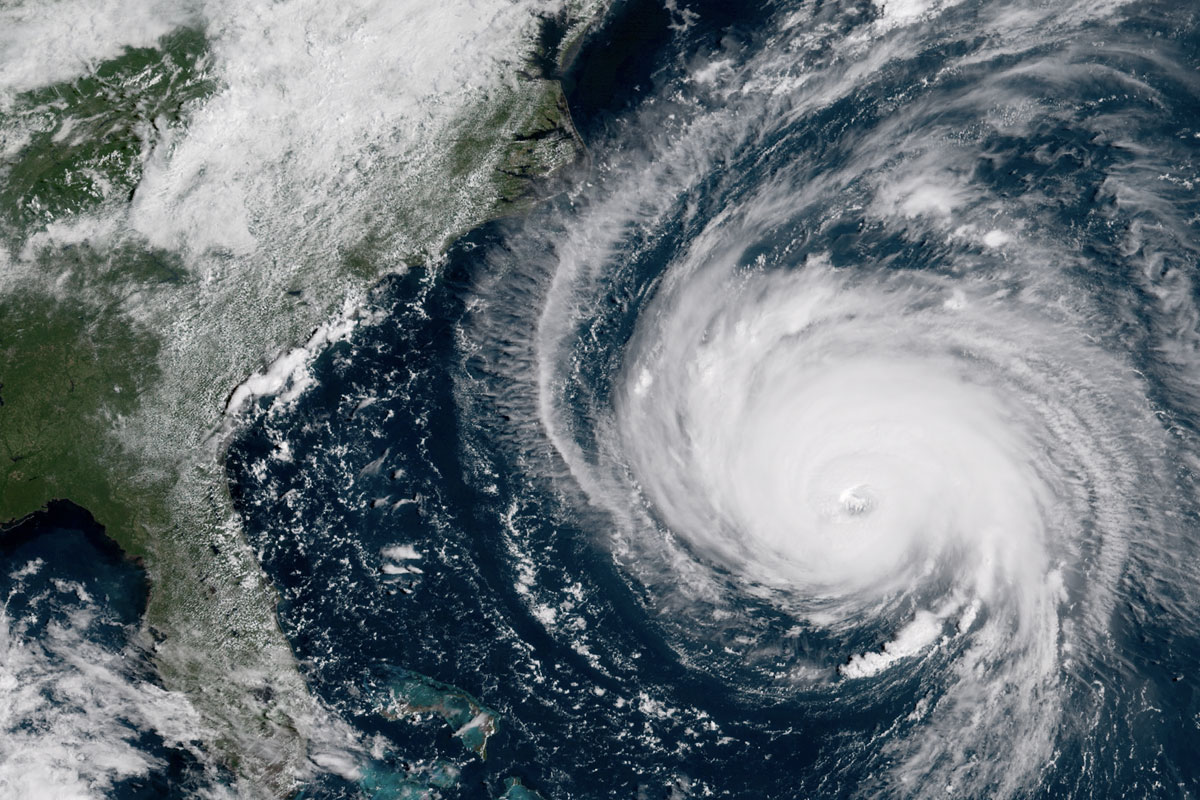“We cannot stop natural disasters but we can arm ourselves with knowledge: so many lives wouldn’t have to be lost if there was enough disaster preparedness.”
~ Petra Němcová
Co-founder and vice chair of All Hands And Hearts—Smart Response
The recent Hurricane Florence—whose tragically disruptive effects are still being felt in the Carolinas weeks after it made landfall on September 14, 2018—is a stark reminder of the importance of emergency preparedness, not just for the personal safety of ourselves and family members, but also for the animals in our care. After all, dogs, cats, and other types of pets with whom we share our homes are very much considered “family”; and, as such, they deserve to be included in our disaster planning.
The biggest challenge, of course, lies in the fact that the term disaster planning is an oxymoron: disasters, almost by definition, are never planned. Whether fire or flood, blizzard or hurricane, tornado or terrorist attack, they tend to occur unexpectedly, creep up on us with little warning, and create a whole host of possible life-threatening scenarios we can never fully anticipate. The best one can do, then, is try and prepare for the most likely of those scenarios.
Here are three steps you can take to help integrate your animals’ needs into your family’s overall emergency preparedness strategies. The rule of thumb is: what’s best for you generally is what will be best for your pet(s).
1. Prepare to Shelter in Place
Disasters come in many forms. Depending on the nature of the situation, your best bet may be simply to stay put. Heed the advice of emergency services personnel and weather officials. If they say, “Stay,” then stay. In this regard, your pet’s familiarity with the home environment will minimize any panic or disorientation that usually accompanies disastrous events.
The one major drawback to this scenario is that you cannot know for sure how long you might have to shelter indoors, or how the event may affect your household utilities, such as heat or running water. Therefore, make sure you have socked away an adequate store—enough to last at least a week—of bottled water, fresh food, treats, medicines, and sanitation needs (e.g., kitty litter).
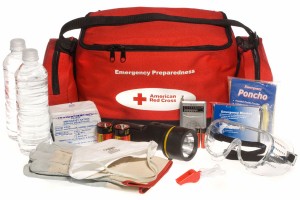
High on the list should also be a pet-specific emergency first-aid kit—which resembles in many ways the kind of first-aid kit you would keep on hand for you and your family. Consult your veterinarian for advice on the most appropriate items to be included in the kit for your pet. In addition, if the impending disaster appears to be especially dire (e.g., an approaching tornado), identify the safest, most secure, and protected room in the house as a place to retreat to before all hell breaks loose. And make sure that space is a pet-friendly one, without obvious hazards to your pet, such as pest control poisons or sharp tools that might inspire its unwitting curiosity.
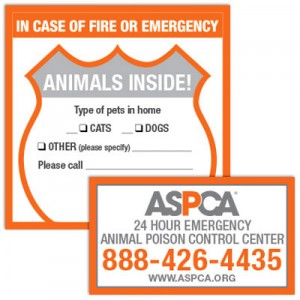 Last but not least, it’s always a good idea to alert local rescue teams that there is a pet residing in the house, should the need arise. The easiest way to do that is to apply an “Animal Inside” sticker in a place that is visible to rescue workers, such as on the entranceway to your home or a front-facing window. Make sure to mark down on the sticker the type and number of animals in the home, as well as their names and your contact info. You can order a free ASPCA “Animal Inside” decal here.
Last but not least, it’s always a good idea to alert local rescue teams that there is a pet residing in the house, should the need arise. The easiest way to do that is to apply an “Animal Inside” sticker in a place that is visible to rescue workers, such as on the entranceway to your home or a front-facing window. Make sure to mark down on the sticker the type and number of animals in the home, as well as their names and your contact info. You can order a free ASPCA “Animal Inside” decal here.
Their Safety Pack also includes a free Animal Poison Control Center refrigerator magnet.
2. Prepare to Evacuate
This one is a bit trickier and requires a certain amount of serious forethought. Most importantly, again, listen to the warnings from emergency services personnel and weather officials. When they say, “Get out,” then get out.
 If at all possible, in a crisis it is always best to take your pet with you. An animal left behind stands a good chance of becoming trapped, lost, or injured, and can create a situation that might endanger emergency responders—whose first priority, after all, is saving human lives. But if you must leave in a hurry without your pet, the aforementioned “Animal Inside” sticker will at least reduce the likelihood of a tragic outcome.
If at all possible, in a crisis it is always best to take your pet with you. An animal left behind stands a good chance of becoming trapped, lost, or injured, and can create a situation that might endanger emergency responders—whose first priority, after all, is saving human lives. But if you must leave in a hurry without your pet, the aforementioned “Animal Inside” sticker will at least reduce the likelihood of a tragic outcome.
The number one rule in an evacuation scenario is: Don’t panic. And the best way to do that is to rehearse your evacuation strategy, the same way you would perform a fire drill. Here planning really is everything. Map out escape routes from the home, and evacuation routes from the area, whether by foot or car. Then test out those routes, over and over, until they become second nature.
You do not want to leave empty-handed unless absolutely necessary! Therefore, ahead of time you should ready a set of clearly labeled “go kits” for both your family and your pet, and keep them up-to-date and accessible at all times, for whatever circumstance that may arise. The kit for your pet should include at minimum these necessary items while you’re on the move:
- Bottled water
- Food (dry and/or canned)
- Treats
- Pet-feeding bowls
- Medications
- First-aid kit
- Towels (cloth and paper)
- Sanitation supplies, including trash bags and litter trays, as well as liquid soap and disinfectant for cleanup
- Spare collars and leashes
- Blankets
- Chew toys
- Copies—on paper or USB drive—of I.D.s and medical records for your pet, including vaccination history and labeled photos (showing both pet and owner for identification purposes)
But even the best-laid plans can go awry. In the event you become separated from your dog or cat, make sure there is a current pet I.D. tag and rabies tag attached to its collar. For added security, ask your vet about having your pet microchipped.
If there are other pet owners in your neighborhood, consider setting up a “buddy system” of mutual support, in case one pet owner doesn’t happen to be around when disaster strikes, and agree on a a pre-arranged meeting place.
Time permitting, make sure to write “Evacuated” on any pet alert decals on your doors or windows if you are able to escape with your animal. This will save responders from wasting valuable time in “rescuing” a pet that isn’t even on the premises.
Once you have safely fled the emergency situation, you also need to decide on a destination. Ideally, a trusted out-of-town friend or relative may take you in temporarily; but if that is not feasible, you may be directed to an evacuation center. Remember, however, that for public health and safety reasons not all emergency shelters can accommodate pets. Research ahead of time possible boarding kennels or animal shelters outside the affected area that would be able to house your pet until the crisis passes. You might also consider a pet-friendly hotel for you and your animal. The following websites will help you locate any such hotels in your vicinity:
Finally, once you are allowed to return home, be aware that there may remain in the area lingering dangers to your pet in the aftermath of the emergency, such as hazardous rubbish, unsanitary debris, or spilled chemical substances. Keep a close eye on your pet until all possible risks have passed.
3. Prepare to Improvise
No plan, however well thought-out, is ever completely bulletproof. By all means, follow the instructions of civic authorities in charge. At the same time, it is equally important to maintain situational awareness and be ready to adapt to changing circumstances as they present themselves.
The key is to remain informed. “Knowledge is power,” as they say, and forewarned is forearmed. Know ahead of time what types of natural and man-made disasters could affect your area—and then stay aware, via conventional and social media, about what hazards may be headed your way.
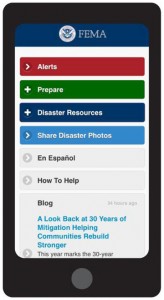
The National Oceanic and Atmospheric Administration is your friend! Keep a radio tuned to your local NOAA Weather emergency station for up-to-the-minute warnings. Stay on top of other radio and TV news broadcasts for relevant developments that may affect you. In addition, you can follow alerts and warnings about severe weather and other hazardous events in your area with the FEMA Emergency Alert mobile app, which also provides information on emergency shelters in your area as well as safety tips for over 20 types of disasters.
For pet owners, FEMA has partnered with the American Kennel Club, the ASPCA, the American Veterinary Medical Association, and the Humane Society to create and distribute a handy two-page Pet Preparedness Manual, which is chock full of useful emergency readiness tips for you and your animal:
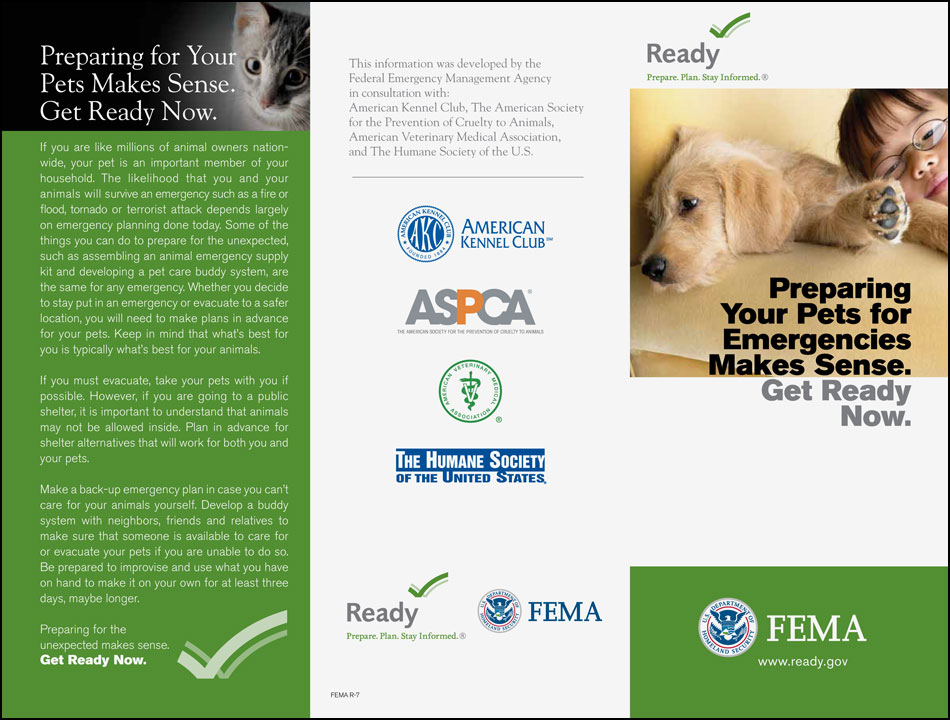
As a pet owner, one of the most valuable digital tools at your disposal is the free ASPCA Pet Safety mobile app, available for both Apple and Android devices. This app guides pet parents in knowing exactly what to do in case of a natural disaster. It also allows pet owners to store important medical records and provides information on making life-saving decisions during natural disasters. With a few swipes, you can:
- Access critical advice on what to do with your pet before, during, and after a major storm—even if there’s no data connectivity
- Store and manage your pet’s critical health records
- Receive a personalized missing pet recovery kit, including step-by-step instructions on how to search for a lost animal in a variety of circumstances
- Build a lost-pet digital flyer that can be shared instantly on your social media channels
- Get the latest and most relevant news about pets and animal welfare
Download the free ASPCA Pet Safety mobile app here:
On the Internet you will find no lack of useful resources from well-known organizations providing vital emergency planning and safety tips for you and your pet in the event of a crisis. Here are a few of the best of them:
- ASPCA: General Pet Care—Disaster Preparedness
- Humane Society: What You Should Have in Your Pet’s First-Aid Kit
- American Red Cross: Pet Disaster Preparedness
- CDC: Disaster Preparedness for Your Pet
- Ready.gov: Pets and Animals
Finally, as a public service, FEMA has produced “Preparing Makes Sense for Pet Owners,” a short instructional video containing information for pet owners and suggestions for proactive pet emergency preparedness.
We at Ketchum Mfg. Co. hope you never have to use this information. But when it comes to disasters…never say “never.” To all our friends and followers—stay safe!


